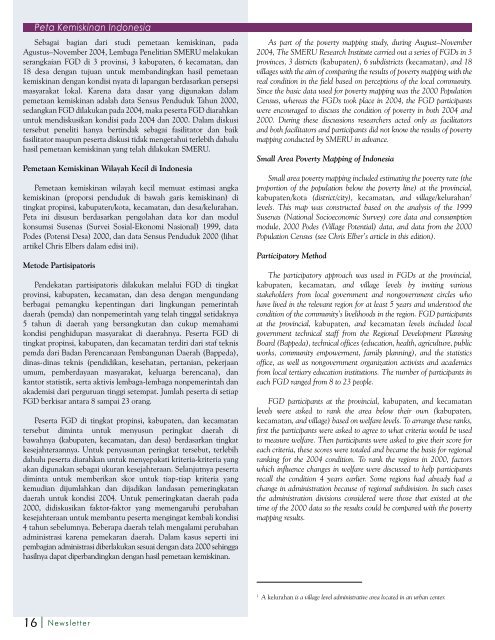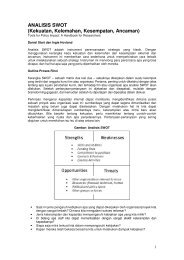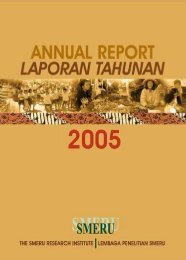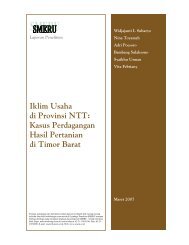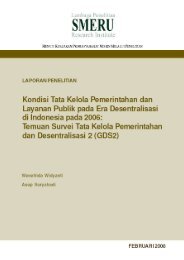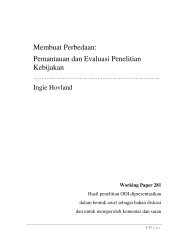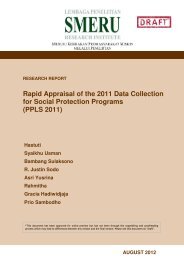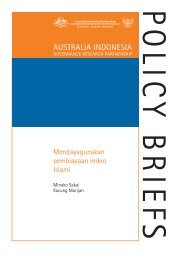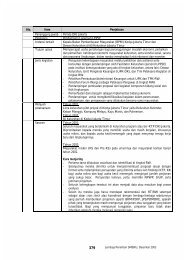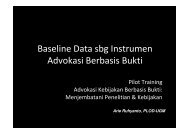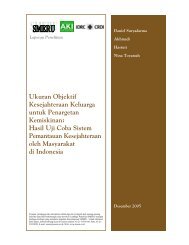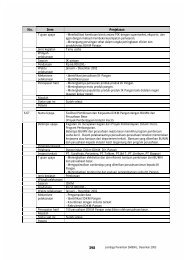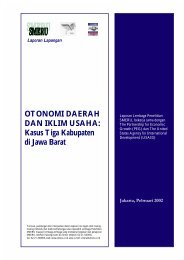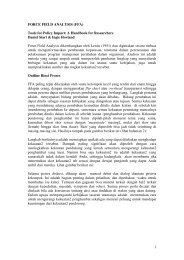PETA KEMISKINAN INDONESIA - SMERU Research Institute
PETA KEMISKINAN INDONESIA - SMERU Research Institute
PETA KEMISKINAN INDONESIA - SMERU Research Institute
You also want an ePaper? Increase the reach of your titles
YUMPU automatically turns print PDFs into web optimized ePapers that Google loves.
Peta Kemiskinan Indonesia<br />
Sebagai bagian dari studi pemetaan kemiskinan, pada<br />
Agustus–November 2004, Lembaga Penelitian <strong>SMERU</strong> melakukan<br />
serangkaian FGD di 3 provinsi, 3 kabupaten, 6 kecamatan, dan<br />
18 desa dengan tujuan untuk membandingkan hasil pemetaan<br />
kemiskinan dengan kondisi nyata di lapangan berdasarkan persepsi<br />
masyarakat lokal. Karena data dasar yang digunakan dalam<br />
pemetaan kemiskinan adalah data Sensus Penduduk Tahun 2000,<br />
sedangkan FGD dilakukan pada 2004, maka peserta FGD diarahkan<br />
untuk mendiskusikan kondisi pada 2004 dan 2000. Dalam diskusi<br />
tersebut peneliti hanya bertindak sebagai fasilitator dan baik<br />
fasilitator maupun peserta diskusi tidak mengetahui terlebih dahulu<br />
hasil pemetaan kemiskinan yang telah dilakukan <strong>SMERU</strong>.<br />
Pemetaan Kemiskinan Wilayah Kecil di Indonesia<br />
Pemetaan kemiskinan wilayah kecil memuat estimasi angka<br />
kemiskinan (proporsi penduduk di bawah garis kemiskinan) di<br />
tingkat propinsi, kabupaten/kota, kecamatan, dan desa/kelurahan.<br />
Peta ini disusun berdasarkan pengolahan data kor dan modul<br />
konsumsi Susenas (Survei Sosial-Ekonomi Nasional) 1999, data<br />
Podes (Potensi Desa) 2000, dan data Sensus Penduduk 2000 (lihat<br />
artikel Chris Elbers dalam edisi ini).<br />
Metode Partisipatoris<br />
Pendekatan partisipatoris dilakukan melalui FGD di tingkat<br />
provinsi, kabupaten, kecamatan, dan desa dengan mengundang<br />
berbagai pemangku kepentingan dari lingkungan pemerintah<br />
daerah (pemda) dan nonpemerintah yang telah tinggal setidaknya<br />
5 tahun di daerah yang bersangkutan dan cukup memahami<br />
kondisi penghidupan masyarakat di daerahnya. Peserta FGD di<br />
tingkat propinsi, kabupaten, dan kecamatan terdiri dari staf teknis<br />
pemda dari Badan Perencanaan Pembangunan Daerah (Bappeda),<br />
dinas-dinas teknis (pendidikan, kesehatan, pertanian, pekerjaan<br />
umum, pemberdayaan masyarakat, keluarga berencana), dan<br />
kantor statistik, serta aktivis lembaga-lembaga nonpemerintah dan<br />
akademisi dari perguruan tinggi setempat. Jumlah peserta di setiap<br />
FGD berkisar antara 8 sampai 23 orang.<br />
Peserta FGD di tingkat propinsi, kabupaten, dan kecamatan<br />
tersebut diminta untuk menyusun peringkat daerah di<br />
bawahnya (kabupaten, kecamatan, dan desa) berdasarkan tingkat<br />
kesejahteraannya. Untuk penyusunan peringkat tersebut, terlebih<br />
dahulu peserta diarahkan untuk menyepakati kriteria-kriteria yang<br />
akan digunakan sebagai ukuran kesejahteraan. Selanjutnya peserta<br />
diminta untuk memberikan skor untuk tiap-tiap kriteria yang<br />
kemudian dijumlahkan dan dijadikan landasan pemeringkatan<br />
daerah untuk kondisi 2004. Untuk pemeringkatan daerah pada<br />
2000, didiskusikan faktor-faktor yang memengaruhi perubahan<br />
kesejahteraan untuk membantu peserta mengingat kembali kondisi<br />
4 tahun sebelumnya. Beberapa daerah telah mengalami perubahan<br />
administrasi karena pemekaran daerah. Dalam kasus seperti ini<br />
pembagian administrasi diberlakukan sesuai dengan data 2000 sehingga<br />
hasilnya dapat diperbandingkan dengan hasil pemetaan kemiskinan.<br />
As part of the poverty mapping study, during August–November<br />
2004, The <strong>SMERU</strong> <strong>Research</strong> <strong>Institute</strong> carried out a series of FGDs in 3<br />
provinces, 3 districts (kabupaten), 6 subdistricts (kecamatan), and 18<br />
villages with the aim of comparing the results of poverty mapping with the<br />
real condition in the field based on perceptions of the local community.<br />
Since the basic data used for poverty mapping was the 2000 Population<br />
Census, whereas the FGDs took place in 2004, the FGD participants<br />
were encouraged to discuss the condition of poverty in both 2004 and<br />
2000. During these discussions researchers acted only as facilitators<br />
and both facilitators and participants did not know the results of poverty<br />
mapping conducted by <strong>SMERU</strong> in advance.<br />
Small Area Poverty Mapping of Indonesia<br />
Small area poverty mapping included estimating the poverty rate (the<br />
proportion of the population below the poverty line) at the provincial,<br />
kabupaten/kota (district/city), kecamatan, and village/kelurahan 1<br />
levels. This map was constructed based on the analysis of the 1999<br />
Susenas (National Socioeconomic Survey) core data and consumption<br />
module, 2000 Podes (Village Potential) data, and data from the 2000<br />
Population Census (see Chris Elber’s article in this edition).<br />
Participatory Method<br />
The participatory approach was used in FGDs at the provincial,<br />
kabupaten, kecamatan, and village levels by inviting various<br />
stakeholders from local government and nongovernment circles who<br />
have lived in the relevant region for at least 5 years and understood the<br />
condition of the community’s livelihoods in the region. FGD participants<br />
at the provincial, kabupaten, and kecamatan levels included local<br />
government technical staff from the Regional Development Planning<br />
Board (Bappeda), technical offices (education, health, agriculture, public<br />
works, community empowerment, family planning), and the statistics<br />
office, as well as nongovernment organization activists and academics<br />
from local tertiary education institutions. The number of participants in<br />
each FGD ranged from 8 to 23 people.<br />
FGD participants at the provincial, kabupaten, and kecamatan<br />
levels were asked to rank the area below their own (kabupaten,<br />
kecamatan, and village) based on welfare levels. To arrange these ranks,<br />
first the participants were asked to agree to what criteria would be used<br />
to measure welfare. Then participants were asked to give their score for<br />
each criteria, these scores were totaled and became the basis for regional<br />
ranking for the 2004 condition. To rank the regions in 2000, factors<br />
which influence changes in welfare were discussed to help participants<br />
recall the condition 4 years earlier. Some regions had already had a<br />
change in administration because of regional subdivision. In such cases<br />
the administration divisions considered were those that existed at the<br />
time of the 2000 data so the results could be compared with the poverty<br />
mapping results.<br />
1<br />
A kelurahan is a village level administrative area located in an urban center.<br />
16 Newsletter


